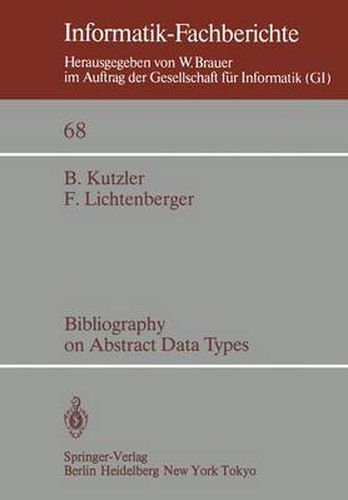Readings Newsletter
Become a Readings Member to make your shopping experience even easier.
Sign in or sign up for free!
You’re not far away from qualifying for FREE standard shipping within Australia
You’ve qualified for FREE standard shipping within Australia
The cart is loading…






This title is printed to order. This book may have been self-published. If so, we cannot guarantee the quality of the content. In the main most books will have gone through the editing process however some may not. We therefore suggest that you be aware of this before ordering this book. If in doubt check either the author or publisher’s details as we are unable to accept any returns unless they are faulty. Please contact us if you have any questions.
It will not be our purpose in this chapter to give an introduction to the field of abstract data types proper. There are many such introductions - see the references in the bibliography. We intend rather to provide a beginner’s guide to the 870 papers cited there. For experts, the 1 i st of those programmi ng languages and systems which appear in the titles should prove useful. We shall not recommend one single paper as a starting point but mention several papers which cover various aspects of the theory. Historically, the papers of [PARNAS 70] and [HOARE 72] are generally regarded as the origins of the field. Parnas introduced the principle of ‘information hiding’ and Hoare emphasized the distinction between an abstract object and it’s concrete representati on. An early survey on specifi cation techni ques for data abstractions is [LISKOV/ZILLES 75]. The starting point for the tremendous expansion of work on algebraically spe- cified abstract data types was, in our OplnlOn, John Guttag’s thesis [GUTTAG 75]. This work was superseded by [GUTTAG/HORNING 78], which is easier to come by. We woul d also strongl y recommend to survey [GUTTAG/HOROWITZ/MUSSER 76a and 76b] for insights into the techniques of algebraically specifiing data types and its impact on software validation. For german speakers we would recommend [KREOWSKI 78] or [KLAEREN 83] which pro- vide excellent introductions.
$9.00 standard shipping within Australia
FREE standard shipping within Australia for orders over $100.00
Express & International shipping calculated at checkout
This title is printed to order. This book may have been self-published. If so, we cannot guarantee the quality of the content. In the main most books will have gone through the editing process however some may not. We therefore suggest that you be aware of this before ordering this book. If in doubt check either the author or publisher’s details as we are unable to accept any returns unless they are faulty. Please contact us if you have any questions.
It will not be our purpose in this chapter to give an introduction to the field of abstract data types proper. There are many such introductions - see the references in the bibliography. We intend rather to provide a beginner’s guide to the 870 papers cited there. For experts, the 1 i st of those programmi ng languages and systems which appear in the titles should prove useful. We shall not recommend one single paper as a starting point but mention several papers which cover various aspects of the theory. Historically, the papers of [PARNAS 70] and [HOARE 72] are generally regarded as the origins of the field. Parnas introduced the principle of ‘information hiding’ and Hoare emphasized the distinction between an abstract object and it’s concrete representati on. An early survey on specifi cation techni ques for data abstractions is [LISKOV/ZILLES 75]. The starting point for the tremendous expansion of work on algebraically spe- cified abstract data types was, in our OplnlOn, John Guttag’s thesis [GUTTAG 75]. This work was superseded by [GUTTAG/HORNING 78], which is easier to come by. We woul d also strongl y recommend to survey [GUTTAG/HOROWITZ/MUSSER 76a and 76b] for insights into the techniques of algebraically specifiing data types and its impact on software validation. For german speakers we would recommend [KREOWSKI 78] or [KLAEREN 83] which pro- vide excellent introductions.